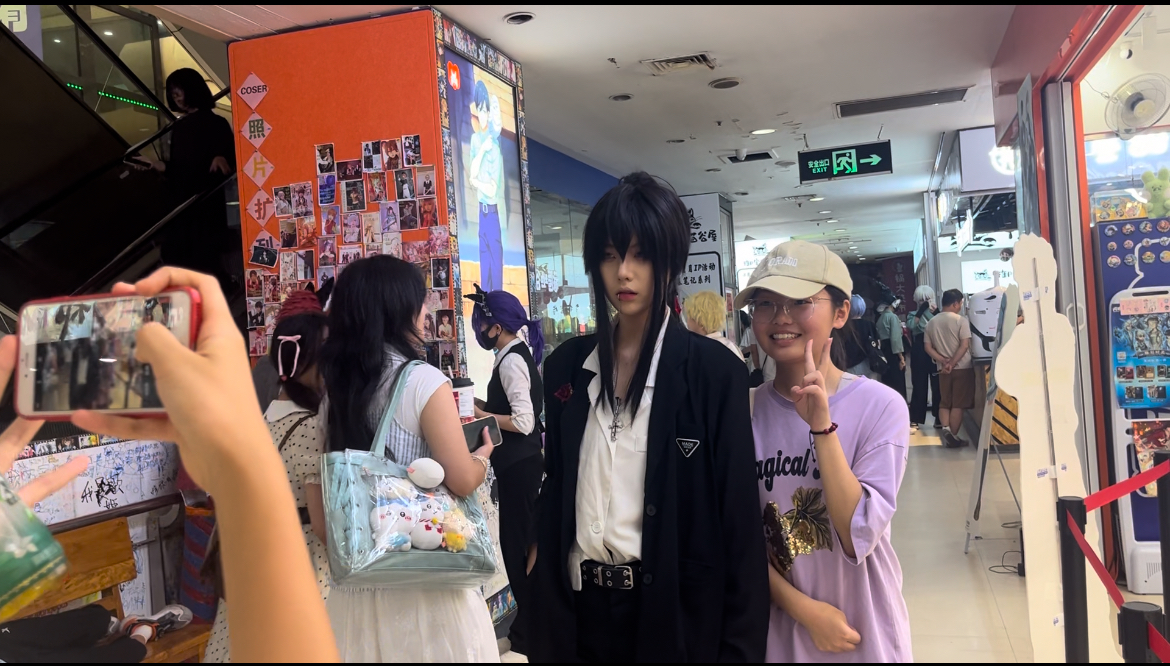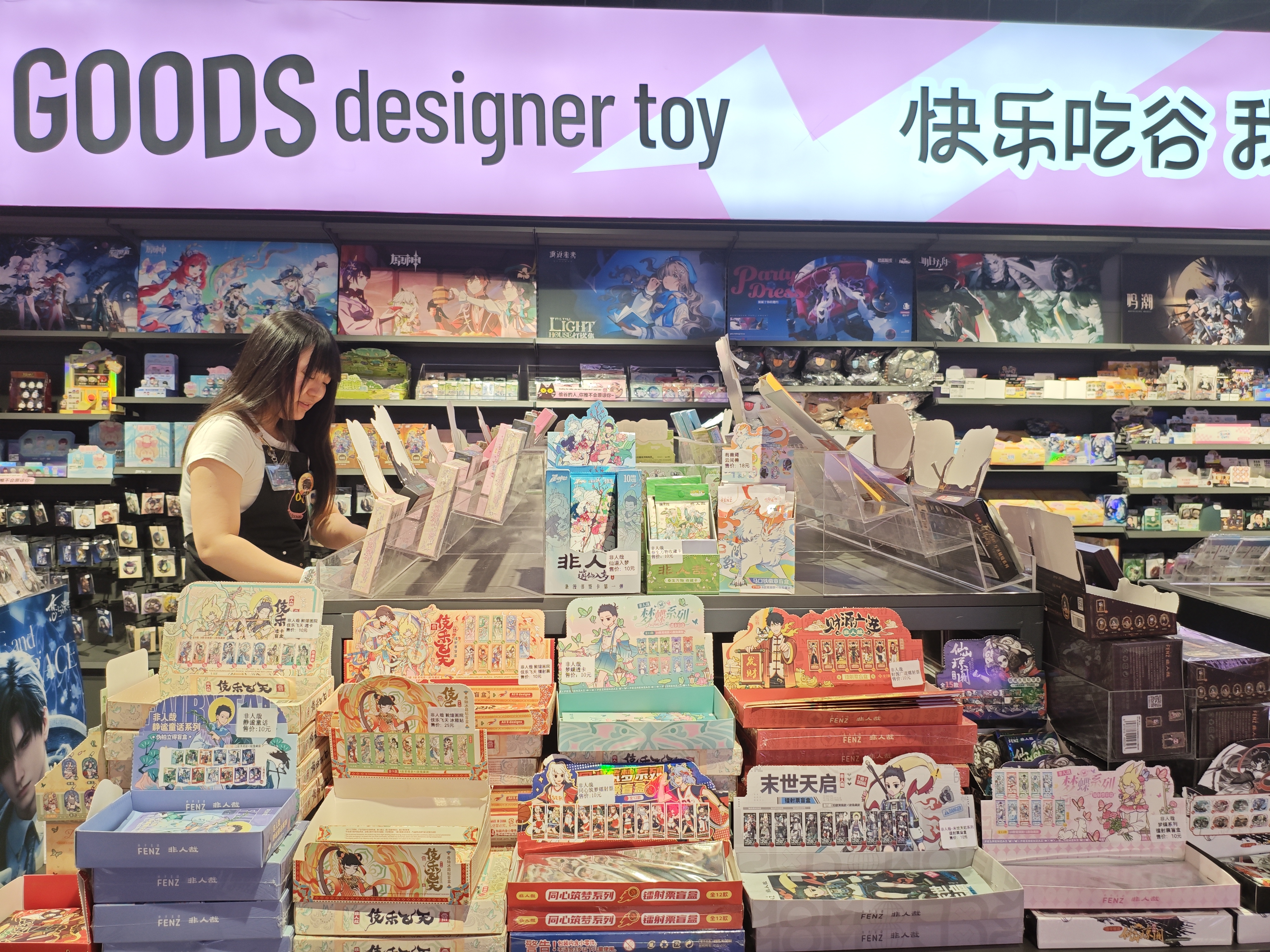Unlocking a new code in trendy consumption: Zhengzhou's 'goods economy' picks up speed
Have you ever heard of the "Goods Economy"? Do you know any young people who are into "Goods-eating"?
Right now, the 2-D economy is booming. Chinese animation IPs like Nezha and Wukong are on the rise, drawing in the post-00s generation as the main driving force behind the "Goods-eating" craze. Major shopping malls in Zhengzhou are rapidly adapting to this trend by embracing 2-D themed businesses, forming a new cultural consumption circle known as the "Goods Circle." From "Goods Carnivals" to "First Release Feasts," Zhengzhou is accelerating innovation through immersive, multi-scenario experiences, unleashing fresh consumer vitality.

"Goods-Eating" Becomes the New Darling of Young Consumers
At Zhengzhou's Grand Shanghai City Mall, just after noon on a weekend, Gen Z shoppers dressed in sweet, quirky, and anime-inspired outfits stream in from all directions-almost like they've agreed to meet there.
Yet just a year ago, this once top-tier mall, located in a prime area of Zhengzhou, was facing declining foot traffic, mass tenant departures, and was on the verge of shutting down. Unexpectedly, since 2023, thousands of 2-D culture fans have been flocking to the Grand Shanghai City. Dozens of "Goods" shops have opened, and the mall now welcomes more than 50,000 visitors a day. It has made a remarkable comeback and is striving to become the largest anime-themed shopping destination in Henan.
Chen Chenggang, Chief Operating Officer of Zhengzhou Grand Shanghai City Commercial Management Co., Ltd., has witnessed both the mall's peak and its transformation. He shared that the mall now hosts 23 "first stores" of 2-D brands and nearly 50 specialty goods shops. A variety of anime IP launch events, debut shows, and exhibitions have turned the space into a hub for anime enthusiasts from across the province.
This youth-driven "Goods-eating" trend is opening new commercial frontiers. Shopping malls across Zhengzhou are enthusiastically embracing Gen Z consumers, enhancing their brand layouts in 2-D entertainment, trendy retail, and collectible toy curation.
The Rise of Chinese Animation IPs like Nezha
Once a niche hobby, 2-D consumption has evolved into a powerful trend reshaping consumer behavior and unlocking market potential. On weekends and holidays, malls take on a distinct atmosphere: trendsetters browse curated stores, break into spontaneous dances, or take street-style selfies in front of displays featuring their favorite IPs and cosplay designs.
On May 14, 23-year-old barista Wan Li sat on the floor of the central hall at the Grand Shanghai City Mall in Zhengzhou. Dangling from her black handbag was her favorite IP card-Hatsune Miku. A 2-D dance performance was playing on the large screen in front of her. She stood up and joined in, swaying happily, fully immersed in the rhythm and relaxation of the moment.
"I've loved anime since I was a kid, especially the some minority IP best. Sometimes I can be happy for several days when I meet my beloved 'goods'," she said. "Anime characters feel like warm, story-filled friends. They give me a sense of companionship and emotional support."
But this year's "Goods Economy" is different. The rise of Chinese animation IPs such as Nezha and Aobing has drawn in the post-00s generation as the main "Goods-eating" force, fueling a new consumption wave across Henan.
Peng Yuhui, 21, assistant manager of a "goods" store in the mall, has seen the shift firsthand. She feels it obvious that "2-D" consumption has shifted to Chinese Cartoon IP. Different from the "2-D" consumption dominated by Japan in previous years, the Nezha series and relevant products were very popular in the market in the first quarter of this year, driving a number of domestic IP such as "Non-Human", "The Graver Robbers' Chronicles" and "Fabulous Beasts" to become a big hit. "Acrylic card, colored paper, refrigerator magnets, clips and through cards, etc., made the monthly sales of our Zhengzhou location exceed 200,000 yuan." "crylic cards, art prints, fridge magnets, clips, and transparent cards are hot sellers. Our Zhengzhou store's monthly sales have now exceeded 200,000 yuan."

"Small Goods" Grow into "Big Industry"
The "Goods economy" is heating up. From myths and legends to classics, from historical stories to modern Chinese cartoons, more and more young people are turning their consumption enthusiasm to domestic cartoon IP. Quietly but surely, "Small Goods" are growing into a "Big Industry". With their passion for buying and collecting, today's young "Goods-eaters" are helping to drive the emergence of a market valued in the tens of billions of yuan.
AI Media Consulting's "2024–2025 China 'Goods Economy' Market Analysis Report" reveals that the market size of China's "Goods Economy" will reach 168.9 billion yuan in 2024, marking a 40.63% increase from 2023. By 2029, the market is expected to surpass 300 billion yuan.
In Henan, the city of Zhengzhou alone is home to over 100 goods stores, establishing itself as a key hub for 2-D culture in China."One-day foot traffic has exceeded 50,000 people, and revenue has increased by nearly 80%," said Chen Chenggang. He noted that the Grand Shanghai City Mall has become a hotspot for 2-Dcultural and creative products, cosplay, and fan conventions. "It's exciting to see iconic Chinese animation characters like Wukong and Nezha becoming today's top-selling hits," Chen added. "We also look forward to seeing Henan's own cultural IPs gain wider recognition."
Term Explanation
The term "Goods"(谷子), derived from the English word "goods," is a buzzword coined by young people who like the second dimension. It mainly refers to merchandise based on copyrighted content from anime, comics, games, novels, and idols- such as badges (also called "baji"), trading cards, plush toys, and keychains. Buying this merchandise is often referred to as "Eating Goods". The consumer culture and economic activity surrounding 2-D IP peripheral commodities is collectively known as "Goods Economy". (Source/Henan Daily Reporter/Qi Yaqiong Translator/Hong Jianyuan Proofreader/Jiao Dan, Tong Lin)
解锁潮流消费新密码,郑州“谷子经济”加速上新
你听说过“谷子经济”吗?你身边有没有“吃谷”年轻人?
当前,二次元经济正值火热,哪吒、悟空等国漫IP崛起,带动00后“吃谷”主力军,郑州各大商场纷纷布局二次元业态,形成了“谷圈”新型文化消费圈。从“谷子狂欢”到“首发盛宴”,郑州正以多元场景加速向“新”,持续撬动消费新活力。
“吃谷”成消费新宠
周末的大上海城,中午刚过12:00,仿佛赴一场约定,微甜风、搞怪风、动漫风等身穿各式服装的Z世代年轻人从四面八方涌入。
而在一年前,这家占据郑州黄金地带的老“顶流”商场,面临人流量下跌、大批商户退场,一度乏人问津,濒临“倒闭”。出乎意料的是,自2023年起,成千上万的二次元爱好者汇聚大上海城,多家“谷子”店入驻,单日人流量也突破5万,大上海城重获新生,致力于做河南最大的二次元动漫商城。
郑州大上海城商业管理有限公司营运总监陈城钢见证了商场的辉煌与转型,他介绍,大上海城陆续进驻了23家二次元品牌“首店”,各类特色谷子店将近50家,动漫IP首发首秀首展活动云集,已成为全省动漫爱好者的集聚地。
年轻人“吃谷”消费的新风向,打开了商业新空间。郑州各大商业综合体积极拥抱Z世代群体,纷纷在二次元商业、潮流商业、潮玩策展等领域加强品牌布局。
哪吒等国漫IP崛起
二次元消费从小众爱好发展为消费新趋势,不断重塑消费结构、释放消费潜能。周末假日的商场别具一格:盛装逛街的潮人们或在品牌集合店“淘宝”,或随机舞蹈,如果碰到自己心仪的妆造IP,他们熟练地街拍打卡……
5月14日,23岁的咖啡师万莉席地坐于郑州大上海城商场中厅,黑色包包上的挂饰是她最爱的日漫“初音未来”IP卡纸,面前大屏上正播放着二次元舞蹈,她随机起舞,沉浸在快乐的摇摆和松弛感中。
“从小就喜欢动漫,最爱一些小众IP,碰到喜欢的‘谷子’能高兴好几天。”她说,动漫里的IP角色就像有故事、有温度的朋友,时常给予自己陪伴和精神激励。
不过,今年的“谷子经济”尤为不同。哪吒、敖丙等国漫IP崛起,带动00后“吃谷”主力军,“谷子经济”撬动河南消费新热潮。
21岁的彭瑜惠是大上海城一“谷子”店副店长,她感受很明显,“二次元”消费转向国漫IP。与往年日漫主导的“二次元”消费不同,今年一季度,哪吒系列周边很受市场欢迎,带动“非人哉”“盗墓笔记”“有兽焉”等一众国漫IP成为大热门。“包括亚克力卡牌、色纸、冰箱贴、夹子和透卡等热卖,让郑州门店月销售突破20万元。”
“小谷子”长成“大产业”
“谷子经济”不断升温,从神话传说到经典名著,从历史故事到现代国漫,越来越多年轻人将消费热情转向国漫IP,悄然间,“小谷子”正在长成“大产业”,热衷“买谷”的年轻人推动了一个千亿级产业的崛起。
艾媒咨询发布的《2024—2025年中国谷子经济市场分析报告》显示,2024年,中国“谷子经济”市场规模达1689亿元,较2023年增长40.63%,预计2029年将超3000亿元。
放眼河南,郑州谷子店数量超过100家,成为全国二次元文化的重要潮流城市。“单日人流量破5万,营业收入增长近80%。”陈城钢说,大上海城已经成为二次元文创产品、妆造、展会的集聚地,“很高兴看到悟空、哪吒等‘国漫之光’变成‘新爆款’,也期待河南本土文化IP早日出圈。”
【名词解释】
所谓“谷子”,源自英语单词“Goods”,是由喜欢二次元的年轻人发展出的一个新兴词汇,主要指漫画、动画、游戏、小说、偶像等版权作品衍生出的周边产品,如徽章(又名“吧唧”)、卡片、玩偶和挂件等,购买“谷子”也被称为“吃谷”。围绕二次元IP周边商品的消费文化与经济形态被称作“谷子经济”。(来源/河南日报 记者/齐亚琼 编译/洪建园 英文审校/焦丹 童林)
Web editors: Shen Jianqi, Li Siyao
